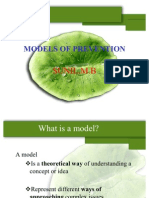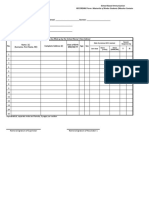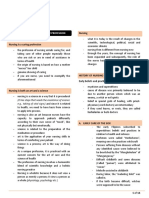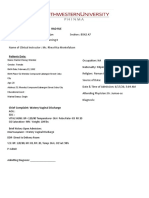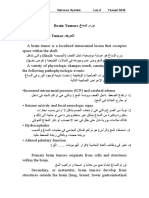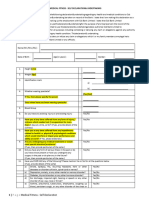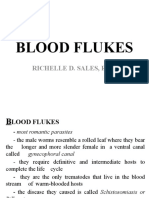Professional Documents
Culture Documents
IL-6: A Potent Target For The Treatment of Rheumatoid Arthritis by In-Silico Approach
Original Title
Copyright
Available Formats
Share this document
Did you find this document useful?
Is this content inappropriate?
Report this DocumentCopyright:
Available Formats
IL-6: A Potent Target For The Treatment of Rheumatoid Arthritis by In-Silico Approach
Copyright:
Available Formats
Volume 4, Issue 10, October – 2019 International Journal of Innovative Science and Research Technology
ISSN No:-2456-2165
IL-6: A Potent Target for the Treatment of
Rheumatoid Arthritis by In-silico Approach
Sneha Bharti 1, Prachi Agnihotri 1, Archana Tiwari 2, Sagarika Biswas 1*
1*
Department of Genomics & Molecular Medicine, CSIR- Institute of Genomics & Integrative Biology, Mall Road, Delhi-110007
2
School of biotechnology, Rajiv Gandhi Technological University, Bhopal- 462033, Madhya Pradesh, India
Abstract:- Rheumatoid Arthritis (RA) is an and less popular. Therefore, there is a necessity of
autoimmune disease affecting life globally. It is alternative biological agent to overcome the related health
characterized by synovial inflammation and joint issues of these drugs. The early diagnosis and treatment of
destruction, eventually inducing severe disability and RA is still giving challenges to the medical field [7].
joint deformity. Many of the research have been done
towards the treatment of RA. Since it is inflammatory The plant comprises of various bioactive compounds
disease, verities of inflammatory cytokines are involved
in RA. IL-6 and TNF-α are most prominently causing that can be considered as a therapeutic agent for RA [8]. In
RA. In this study we are looking for an inhibitory this study, we are approaching towards the bioactive
compound of natural origin which can be used to target compounds of Aloevera and Murraya koenigii (commonly
the above two inflammatory factors. Two plants namely known as curry leaves) as these plants possess different
Aloevera and Murraya koenigii were selected to find out medicinal properties such as antioxidant, anti-microbial and
the activity of their active compounds to inhibit the anti-inflammatory that accelerates wound healing and burn,
target interleukin 6 (IL-6). The protein-ligand docking immunity, itching, blood disorders, improves digestion and
plays an important role in structural based drug skin eruptions [9, 10, 11]. IL-6 is the key cytokine in the
designing. Various molecular docking tools namely pathogenesis of RA, its role in synovitis and joint damage
SwissDock, PatchDock, Argus Lab 4.0.1, UCSF makes it the potential target. The bioavailability of the
Chimera-Autodock Vina and Hex 8.0 were used to find bioactive compounds of these two plants used to target the
the best scoring function of protein ligand interaction. IL-6 by molecular docking and was checked with
Molecular docking followed by ADME/Tox to limit the ADME/Tox tool.
study of molecular docking was used on the basis of
Lipinski rule of five. The results of these tools showed The various pro-inflammatory cytokines entailed in
that out of 10 active components of both the plants only articular cartilage destruction during disease. The present
two have potential to be an inhibitor of the IL-6. The research targeted the IL-6, to obtain a compound of the
aloe emodin of Aloevera and phebalosin of Murraya natural origin which can be further used as predictive drug
koenigii have spontaneous binding with IL-6 protein. treatment. To achieve this, different steps and
These active compounds have potential which can be bioinformatics tools were used for the validation and
used as drug to treat the inflammatory condition of RA. screening of the compounds on the basis of their properties.
Keywords:- Autoimmune Disease, Molecular Docking, TNF II. MATERIAL AND METHODS
-α, SwissADME, Lipinski Rule.
A. Protein Preparation
I. INTRODUCTION The crystallographic structure of IL-6 bearing PDB
(Protein Data Bank) ID: 1ALU retrieved from the RCSB
RA is a chronic inflammatory autoimmune disease (Research Collaboratory for Structural Bioinformatics)
resulting into mortality, severe disability and bones protein databank (www.rcsb.org). The ribbon model of IL-6
deformity globally [1, 2]. It is characterized by the pannus shown in figure 1 and the stereochemistry of the protein
formation in synovial membrane, deformity in affected structure was analysed by the PROCHECK tool
joints, leading to dysfunction of the interior milieu of (http://services.mbi.ucla.edu/PROCHECK/) for assessing
joints [3]. Women are largely affected then men that the quality on the basis of Ramachandran Plot [12].
degrade the quality of health and increase the
difficulties because it increases vividly around the time B. Ligand Preparation
The bioactive compound structures of Aloevera are
of menopause [4]. Since 1998, lot of advancement has aloin, campesterol, β-sitosterol, lupeol and aloe emodin and
been achieved for the treatment of RA such as Disease Murraya koenigii are quercitin, catechin, epicatechin,
Modifying Anti-Rheumatic Drugs (DMARDS) [5], NSAIDS phebalosin and mukonicine. The structures were taken
and steroids to control the disease activity and they have from the NCBI PubChem compound database
become anchor for the treatment of RA [6]. The high (www.pubchem.ncbi.nlm.nih.gov/), drawn with the help
cost and adverse effects of drugs makes it unaffordable of Marvin Sketch and were saved as mol2 format and
IJISRT19OCT1802 www.ijisrt.com 749
Volume 4, Issue 10, October – 2019 International Journal of Innovative Science and Research Technology
ISSN No:-2456-2165
PDB format. The pharmacokinetics evaluation was of Aloevera and phebalosin of Murraya koenigii attained
performed using the Swiss ADME/Tox based on the the satisfactory binding energies (Table 3) and graphically
Lipinski rule of 5[13]. The prepared ligand structures were represented in figure 3. Binding energy is the energy
analysed by SwissADME on the basis of Lipinski rule of utilised by the ligand to dock with the receptor. The more
five. Lipinski rule of five helped to determine the negative the energy the more stable the conformation. The
physicochemical, lipophilicity, water solubility, medicinal ligands ranked according to the binding energy they
chemistry, pharmacokinetics and drug likeliness of the used to reach the stable conformation. Aloe emodin and
selected compounds. For drug likeliness molecular Phebalosin has been proved to be the appropriate ligand
weight, number of hydrogen bond donor, number of that binds to the protein molecule with maximum binding
hydrogen bond acceptor and total polar surface should come energy.
under Lipinski rule of five.
Interactions among IL-6 and other proteins using
C. Molecular Docking STRING database provides the description of various
Protein–ligand docking plays significant role in interacting partner of IL-6 such as interleukins like IL-4
predicting the orientation of the ligand on binding with which participates in the B-cell activation process, IL-10
the protein. The docking of bioactive compounds with IL-6 inhibits the synthesis of a number of cytokines like IFN-
protein were performed using 5 different tools namely gamma, IL-2, IL-3, TNF and GM-CSF pathway, IL-13
SwissDock, PatchDock, Argus Lab 4.0.1, UCSF inhibits inflammatory cytokine production and SOCS
Chimera-AutoDock Vina and Hex 8.0. SwissDock and (Suppressor of cytokine signalling 3) which is involved in
negative regulation of cytokines that signal through the
PatchDock are online servers [14, 15] whereas, Argus Lab JAK/STAT pathway.
4.0.1, UCSF Chimera-AutoDock Vina and Hex8.0 are
offline tools used for flexible docking [16, 17, 18]. IV. DISCUSSION
D. Protein-Protein Interaction RA is an autoimmune disease affecting joints and
The interaction within the proteins is helpful to leads to disability. The disease can be targeted by different
know about the novel therapeutic approaches. STRING available drugs targeting the various biological
Database (Search Tool for Retrieval of Interacting pathways. It is reported that IL-6 is the most
Genes/Proteins) (https://string-db.org/) has been used to significant cytokines causing synovitis deformities in the
identify the interaction between IL-6 and other proteins. joints of the RA patients [2]. Present research aims to target
The study will enable us to analyse metabolic and signal the prominent cytokine IL-6 by the naturally occurring
transduction and also the pharmacogenetics research [19]. compound through in-silico approach. Earlier, Aloevera has
been reported for the treatment of RA by not extracting the
III. RESULT bioactive compounds but by preparing the extract of leaves
for inhibiting the inflammatory factors; but this study
The bioactive compound structures of Aloevera are focuses basically on the bioactive compounds present in
aloin, campesterol, β-sitosterol, lupeol and aloe emodin and plant, to find out the basically which bioactive compound
Murraya koenigii are quercitin, catechin, epicatechin, responsible for this inhibitory action [20]. In this study two
phebalosin and mukonicine properties were analysed on the plants Murraya koenigii and Aloevera having anti-
basis of Lipinski rule of five (Table 1). Lipinski rule inflammatory properties, makes them more suitable to
of five helped to determine the physicochemical,
lipophilicity, water solubility, medicinal chemistry, target the IL-6 [8, 10]. The in-silico approach gives the
pharmacokinetics and drug likeliness of the selected prediction of the analysis before approaching towards
compounds. For drug likeliness molecular weight, number laboratory experiments. The bioactive compound of
of hydrogen bond donor, number of hydrogen bond acceptor Aloevera are aloin, campesterol, β-sitosterol, lupeol and
and total polar surface should come under Lipinski rule of aloe emodin and Murraya koenigii are quercitin,
five using SwissADME and their structures were drawn catechin, epicatechin, phebalosin and mukonicine were
using Marvin sketch (Table 2). selected for the molecular docking followed up by the
Procheck and swissADME analysis. It enables to validate
The IL-6 protein was validated, using PROCHECK the protein and the compound for the flexible molecular
tool. According to the standard percentage, the most docking [11]. The docking study with the different tools
favoured region should consist of more than 90%. The results the scoring function of ligand with the receptor
Ramachandran plot of IL-6 interprets that the total binding site. Two bioactive compounds aloe emodin and
number of residues are 157 and residues under most phebalosin have the potential to act as a drug for inhibition
favoured region are 139 i.e. 95.2% (Figure 2). of IL-6. The binding energy of the Aloe emodin resulted in
5 molecular docking tools namely SwissDock,
Ligands, aloe emodin and phebalosin and the PatchDock, Argus Lab 4.0.1, UCSF Chimera- AutoDock
receptor 1ALU were subjected to the docking procedure Vina and Hex 8.0 were -7.73, -3.748, 8.478, -8.98 and -
with the SwissDock, PatchDock, Argus Lab 4.0.1, 192.16, and of phebalosin was -6.98, -3.87, -7.884, -6.48
UCSF Chimera-Autodock Vina and Hex 8.0 (Figure 4). and -223.35 Kcal/mole. The binding energy of these two
On the basis of obtained binding energies, the aloe emodin compounds was higher among all the 10 selected
IJISRT19OCT1802 www.ijisrt.com 750
Volume 4, Issue 10, October – 2019 International Journal of Innovative Science and Research Technology
ISSN No:-2456-2165
compounds. The more negative the energy, the more stable [8]. Amirghofran Z, Herbal medicines for
the conformation of the docked compound. Furthermore, the immunosuppression, Iran J Allergy Asthma
protein protein interaction analysis performed using Immunol,11, 111-19, 2011.
STRING Database, provides the base to study about [9]. Pulok KM, Neelesh KN, Niladri M, Phytochemical
pharmacogenetics research, metabolic and signal and therapeutic profile of Aloevera, J Nat Med,
transduction pathway. Above study suggests aloe emodin 14(1), 2320-3358, 2014.
and phebalosin as the potential compound out of 10 selected [10]. Tanwi C, Shubhnagee S, Pramod K, Extraction and
compounds to target the protein for anti- inflammation Identification of Bioactive components from Aloe
which further needs to be validated by in vitro and in vivo barbedensis Miller, J Pharmacon Phytochem, 2, 14-23,
approaches. 2013.
[11]. Hanan AH, Uma MI, Sarah A, The Antibacterial
V. CONCLUSION effect of Curry Leaves (Murraya Koenigii), Eur J
Pharm Med Res, 3(10), 382-367, 2016.
Compounds derived from natural origin are capable to [12]. Tamiris MA, Daiana TM, Teodorico CR, In Silico
treat RA as novel therapeutic agents. Formulations of these Study of Leishmania donovani- Tubulin and
compounds are mostly preferred by the traditional system Inhibitors, J Chem, 1-8, 2014.
of medicine. This study shows that the aloe emodin and [13]. Antoine D, Olivier M, Vincent Z, SwissADME: a
phebalosin are potential inhibitor of IL-6 and have better free web tool to evaluate pharmacokinetics,
activity than other compounds as these compounds shows druglikeliness and medicinal chemistry friendliness of
more stable conformation. The anti-inflammatory property small molecules, Nat Sci Rep, 7, 42714, 2017.
of these two compounds further needs to be validated by in [14]. Raphael TA, Tayo AA, Babatunji EO, Structural
vitro and in vivo approaches. Studies of Predicted Ligand Binding Sites and
Molecular Docking Analysis of Slc2a4 as a
REFERENCES Therapeutic Target for the Treatment of Cancer, Int J
Mol Sci, 19, 386, 2018.
[1]. Klareskog L, Catrina AI, Paget S, Rheumatoid [15]. Aurelien G, Vincent Z, Olivier M, SwissDock, a
Arthritis, Lancet, 373, 659-72, 2009. protein-small molecule docking web service based on
[2]. Jing W, Yuan Q, Jia-xin D, Molecular docking EADock DSS, Nucleic Acid Res, 39, 270-277, 2011.
studies of kirenol a traditional Chinese medicinal [16]. Ambreen H, Zafar SS, Afshan N, Molecular Docking
compound against rheumatoid arthritis cytokine drug Study on theInteraction of Riboflavin (Vitamin B2) and
targets (TNF-α, IL-1, IL-6), Biomed Res, 28 (5), 1992- Cyanocobalamin (Vitamin B12) Coenzymes, J Comp
1995, 2017. Med, 1-5, 2013.
[3]. Silman AJ, Pearson JE, Epidemiology and genetics of [17]. Natraj SP, Khajomohiddin S, Jack T, Softwares for
rheumatoid arthritis, Arthritis Res, 4(Suppl. 3), S265– molecular docking: a review, Biophys Rev, 9, 91- 102,
S272, 2002. 2017.
[4]. Pincus T, Callahan LF, Reassessment of twelve [18]. Sai H, Raj Kumar, Siva SR, Docking Studies of
traditional paradigms concerning the diagnosis, Benzimidazole Derivatives using HEX 8.0, IJSPR,
prevalence, morbidity, and mortality of rheumatoid 8(4), 1677-1688, 2017.
arthritis, Scand J Rheumatol, 79, 67-96, 1989. [19]. Damian S, Annika LG, David L, STRING v11:
[5]. Fernandez-Cruz E, Alecsandru D, Rodriguez- protein–protein association networks with increased
Sainz C, Introduction to biological drugs, coverage, supporting functional discovery in genome-
Actas Dermosifiliogr, 99, 2-6, 2008. wide experimental datasets, Nucleic Acid Res, 47,
[6]. Saag, KG, Teng GG, Patkar NM, American 607-613, 2019.
college of Rheumatology 2008 recommendations for [20]. Subhashis P, Tanmoy D, Tapas KC, Soumen B,
the biologic disease-modifying antirheumatic drugs in Curative and protective properties of crude gel of
drugs in rheumatoid arthritis, Arthritis Rheumatol, 59, Aloevera from sub-Himalyan West Bengal in
762-784, 2008. chronic and acute inflammatory rat models, Indian
[7]. McInnes IB, Schett G, The Pathogenesis of J Tradit Know, 16(1), 121-127, 2017.
Rheumatoid Arthritis. Mechanism of disease, N Engl J
Med, 365, 2205-2219, 2011.
IJISRT19OCT1802 www.ijisrt.com 751
Volume 4, Issue 10, October – 2019 International Journal of Innovative Science and Research Technology
ISSN No:-2456-2165
FIGURE LEGENDS:
Fig 1:- Ribbon model view of IL-6 protein using Discovery studio 4.0.
Fig 2:- Ramachandran plot of IL-6 protein.
IJISRT19OCT1802 www.ijisrt.com 752
Volume 4, Issue 10, October – 2019 International Journal of Innovative Science and Research Technology
ISSN No:-2456-2165
Fig 3:- Representation of the binding energy (Kcal/mole) of the ligands resulted from the docking tools; Aloe emodin and
Phebalosin are the two potent compounds.
Fig 4:- Docking images of a) Aloe emodin and b) Phebalosin using SwissDock server.
IJISRT19OCT1802 www.ijisrt.com 753
Volume 4, Issue 10, October – 2019 International Journal of Innovative Science and Research Technology
ISSN No:-2456-2165
Figure 5: IL-6 interaction with other proteins using STRING Database.
Table Legends:
Compound Molecular H-bond H-bond Donor Rotatable
Name Weight(g/mol) Acceptor Bonds
Aloin 418.39 9 6 3
Aloe emodin 270.24 5 3 1
β-Sitosterol 414.71 1 1 6
Lupeol 426.72 1 1 1
Campesterol 400.68 1 1 5
Quercitin 302.24 7 5 1
Phebalosin 258.27 4 0 3
Mukonicine 323.39 3 1 2
Catechin 290.27 6 5 1
Epicatechin 289.14 6 5 2
Table 1:- Molecular weight, hydrogen bond donor, hydrogen bond acceptor and rotational bond of different ligands using
SwissADME software.
IJISRT19OCT1802 www.ijisrt.com 754
Volume 4, Issue 10, October – 2019 International Journal of Innovative Science and Research Technology
ISSN No:-2456-2165
Ligand Name Ligand Structure
Aloin
(10S)-1,8-dihydroxy-(hydroxymethyl)-10- [(2S,3R,4R,5S,6R)-
3,4,5-trihydroxy-6- (hydroxymethyl) oxan-2-yl]-10H-
anthracen-9- one
Aloe emodin
1,8-dihydroxy-3-(hydroxymethyl)anthracene-9,10-dione
β-Sitosterol
(3S,8S,9S,10R,13R,14S,17R)-17-[(2R,5R)-5- ethyl-6-
methylheptan-2-yl]-10,13-dimethyl-
2,3,4,7,8,9,11,12,14,15,16,17-dodecahydro-1H-
cyclopenta[a]phenanthren-3-ol
Lupeol
(1R,3aR,5aR,5bR,7aR,9S,11aR,11bR,13aR,13 bR)-
3a,5a,5b,8,8,11a-hexamethyl-1-prop-1-en-2-yl
1,2,3,4,5,6,7,7a,9,10,11,11b,12,13,13a,13b-
hexadecahydrocyclopenta[a]chrysen-9-ol
Campesterol
(3S,8S,9S,10R,13R,14S,17R)-17-[(2R,5R)-5,6-dimethylheptan-
2-yl]-10,13-dimethyl-2,3,4,7,8,9,11,12,14,15,16,17-
dodecahydro-1H-cyclopenta[a] phenanthren-3-ol
Quercitin
2-(3,4-dihydroxyphenyl)-3,5,7- trihydroxychromen-4-one
IJISRT19OCT1802 www.ijisrt.com 755
Volume 4, Issue 10, October – 2019 International Journal of Innovative Science and Research Technology
ISSN No:-2456-2165
Mukonicine
8,10-dimethoxy-3,3,5-trimethyl-11H- pyrano[3,2-a] carbazole
Phebalosin
7-methoxy-8-[(2R,3R)-3-prop-1-en-2- yloxiran-2-yl]chromen-
2-one
Catechin
(2R,3S)-2-(3,4-dihydroxyphenyl)-3,4-dihydro-2H-chromene-
3,5,7-triol
Epicatechin
(2R,3R)-2-(3,4-dihydroxyphenyl)-3,4-dihydro-2H-chromene-
3,5,7-triol
Table 2:- Ligands structure drawn using Marvin Sketch 19.8.
Ligands Binding Energy (Kcal/Mole) with 1ALU
Selected Active Argus SwissDock Hex8.0 UCSF PatchDock
Plants Compounds -8.478 -7.73 -192.16 -8.98 -3.748
Aloevera Aloe emodin
Murrraya Lupeol -4.656 -6.68 -306.47 -3.45 -5.458
Campesterol -4.805 -7.18 -276.46 -5.1 -4.72
β- sitosterol -4.267 -2.56 -254.22 -4.23 -5.074
Aloin -4.696 -7.31 -247.31 -6.56 -4.232
Quercitin -4.556 -7.49 -254.18 -6.2 -4.56
koeinigii Catechin -4.615 -6.73 -250.66 -5.9 -3.674
Phebalosin -7.884 -6.98 -223.25 -6.48 -3.87
Mukonicine -3.592 -6.91 -208.54 -5.9 -2.904
Epicatechin -4.600 -7.32 -250.82 -5.6 -3.564
Table 3:- Binding energy (Kcal/mole) of different ligands docked with IL-6 protein (PDB ID:1ALU).
IJISRT19OCT1802 www.ijisrt.com 756
You might also like
- A Heartbreaking Work Of Staggering Genius: A Memoir Based on a True StoryFrom EverandA Heartbreaking Work Of Staggering Genius: A Memoir Based on a True StoryRating: 3.5 out of 5 stars3.5/5 (231)
- The Sympathizer: A Novel (Pulitzer Prize for Fiction)From EverandThe Sympathizer: A Novel (Pulitzer Prize for Fiction)Rating: 4.5 out of 5 stars4.5/5 (121)
- Grit: The Power of Passion and PerseveranceFrom EverandGrit: The Power of Passion and PerseveranceRating: 4 out of 5 stars4/5 (588)
- Never Split the Difference: Negotiating As If Your Life Depended On ItFrom EverandNever Split the Difference: Negotiating As If Your Life Depended On ItRating: 4.5 out of 5 stars4.5/5 (838)
- The Little Book of Hygge: Danish Secrets to Happy LivingFrom EverandThe Little Book of Hygge: Danish Secrets to Happy LivingRating: 3.5 out of 5 stars3.5/5 (400)
- Devil in the Grove: Thurgood Marshall, the Groveland Boys, and the Dawn of a New AmericaFrom EverandDevil in the Grove: Thurgood Marshall, the Groveland Boys, and the Dawn of a New AmericaRating: 4.5 out of 5 stars4.5/5 (266)
- The Subtle Art of Not Giving a F*ck: A Counterintuitive Approach to Living a Good LifeFrom EverandThe Subtle Art of Not Giving a F*ck: A Counterintuitive Approach to Living a Good LifeRating: 4 out of 5 stars4/5 (5794)
- Her Body and Other Parties: StoriesFrom EverandHer Body and Other Parties: StoriesRating: 4 out of 5 stars4/5 (821)
- The Gifts of Imperfection: Let Go of Who You Think You're Supposed to Be and Embrace Who You AreFrom EverandThe Gifts of Imperfection: Let Go of Who You Think You're Supposed to Be and Embrace Who You AreRating: 4 out of 5 stars4/5 (1090)
- The World Is Flat 3.0: A Brief History of the Twenty-first CenturyFrom EverandThe World Is Flat 3.0: A Brief History of the Twenty-first CenturyRating: 3.5 out of 5 stars3.5/5 (2259)
- The Hard Thing About Hard Things: Building a Business When There Are No Easy AnswersFrom EverandThe Hard Thing About Hard Things: Building a Business When There Are No Easy AnswersRating: 4.5 out of 5 stars4.5/5 (345)
- Shoe Dog: A Memoir by the Creator of NikeFrom EverandShoe Dog: A Memoir by the Creator of NikeRating: 4.5 out of 5 stars4.5/5 (537)
- The Emperor of All Maladies: A Biography of CancerFrom EverandThe Emperor of All Maladies: A Biography of CancerRating: 4.5 out of 5 stars4.5/5 (271)
- Team of Rivals: The Political Genius of Abraham LincolnFrom EverandTeam of Rivals: The Political Genius of Abraham LincolnRating: 4.5 out of 5 stars4.5/5 (234)
- Hidden Figures: The American Dream and the Untold Story of the Black Women Mathematicians Who Helped Win the Space RaceFrom EverandHidden Figures: The American Dream and the Untold Story of the Black Women Mathematicians Who Helped Win the Space RaceRating: 4 out of 5 stars4/5 (895)
- Elon Musk: Tesla, SpaceX, and the Quest for a Fantastic FutureFrom EverandElon Musk: Tesla, SpaceX, and the Quest for a Fantastic FutureRating: 4.5 out of 5 stars4.5/5 (474)
- AnalgesicDocument62 pagesAnalgesicAnjum IslamNo ratings yet
- On Fire: The (Burning) Case for a Green New DealFrom EverandOn Fire: The (Burning) Case for a Green New DealRating: 4 out of 5 stars4/5 (74)
- The Yellow House: A Memoir (2019 National Book Award Winner)From EverandThe Yellow House: A Memoir (2019 National Book Award Winner)Rating: 4 out of 5 stars4/5 (98)
- The Unwinding: An Inner History of the New AmericaFrom EverandThe Unwinding: An Inner History of the New AmericaRating: 4 out of 5 stars4/5 (45)
- Models of PreventionDocument80 pagesModels of Preventionsunielgowda88% (8)
- Healing From Heaven by Pastor Chris OyakhilomeDocument201 pagesHealing From Heaven by Pastor Chris OyakhilomeTega Edafiogho100% (24)
- VPT 411 Veterinary Chemotherapy Tanuvas Lecture NotesDocument94 pagesVPT 411 Veterinary Chemotherapy Tanuvas Lecture NotesSunil100% (41)
- Child With Respiratory DysfunctionDocument23 pagesChild With Respiratory DysfunctionmeganNo ratings yet
- Recording Forms (Masterlist) School Forms - Kinder To Grade 7Document16 pagesRecording Forms (Masterlist) School Forms - Kinder To Grade 7lourdes estopaciaNo ratings yet
- Deep Breathing ChecklistDocument5 pagesDeep Breathing Checklistacademic purposesNo ratings yet
- Detection and Counting of Fake Currency & Genuine Currency Using Image ProcessingDocument6 pagesDetection and Counting of Fake Currency & Genuine Currency Using Image ProcessingInternational Journal of Innovative Science and Research Technology100% (9)
- An Overview of Lung CancerDocument6 pagesAn Overview of Lung CancerInternational Journal of Innovative Science and Research TechnologyNo ratings yet
- Entrepreneurial Creative Thinking and Venture Performance: Reviewing the Influence of Psychomotor Education on the Profitability of Small and Medium Scale Firms in Port Harcourt MetropolisDocument10 pagesEntrepreneurial Creative Thinking and Venture Performance: Reviewing the Influence of Psychomotor Education on the Profitability of Small and Medium Scale Firms in Port Harcourt MetropolisInternational Journal of Innovative Science and Research TechnologyNo ratings yet
- Digital Finance-Fintech and it’s Impact on Financial Inclusion in IndiaDocument10 pagesDigital Finance-Fintech and it’s Impact on Financial Inclusion in IndiaInternational Journal of Innovative Science and Research TechnologyNo ratings yet
- Impact of Stress and Emotional Reactions due to the Covid-19 Pandemic in IndiaDocument6 pagesImpact of Stress and Emotional Reactions due to the Covid-19 Pandemic in IndiaInternational Journal of Innovative Science and Research TechnologyNo ratings yet
- Auto Tix: Automated Bus Ticket SolutionDocument5 pagesAuto Tix: Automated Bus Ticket SolutionInternational Journal of Innovative Science and Research TechnologyNo ratings yet
- Designing Cost-Effective SMS based Irrigation System using GSM ModuleDocument8 pagesDesigning Cost-Effective SMS based Irrigation System using GSM ModuleInternational Journal of Innovative Science and Research TechnologyNo ratings yet
- Computer Vision Gestures Recognition System Using Centralized Cloud ServerDocument9 pagesComputer Vision Gestures Recognition System Using Centralized Cloud ServerInternational Journal of Innovative Science and Research TechnologyNo ratings yet
- Effect of Solid Waste Management on Socio-Economic Development of Urban Area: A Case of Kicukiro DistrictDocument13 pagesEffect of Solid Waste Management on Socio-Economic Development of Urban Area: A Case of Kicukiro DistrictInternational Journal of Innovative Science and Research TechnologyNo ratings yet
- Utilization of Waste Heat Emitted by the KilnDocument2 pagesUtilization of Waste Heat Emitted by the KilnInternational Journal of Innovative Science and Research TechnologyNo ratings yet
- Ambulance Booking SystemDocument7 pagesAmbulance Booking SystemInternational Journal of Innovative Science and Research TechnologyNo ratings yet
- Predictive Analytics for Motorcycle Theft Detection and RecoveryDocument5 pagesPredictive Analytics for Motorcycle Theft Detection and RecoveryInternational Journal of Innovative Science and Research TechnologyNo ratings yet
- Smart Cities: Boosting Economic Growth Through Innovation and EfficiencyDocument19 pagesSmart Cities: Boosting Economic Growth Through Innovation and EfficiencyInternational Journal of Innovative Science and Research TechnologyNo ratings yet
- Factors Influencing The Use of Improved Maize Seed and Participation in The Seed Demonstration Program by Smallholder Farmers in Kwali Area Council Abuja, NigeriaDocument6 pagesFactors Influencing The Use of Improved Maize Seed and Participation in The Seed Demonstration Program by Smallholder Farmers in Kwali Area Council Abuja, NigeriaInternational Journal of Innovative Science and Research TechnologyNo ratings yet
- Study Assessing Viability of Installing 20kw Solar Power For The Electrical & Electronic Engineering Department Rufus Giwa Polytechnic OwoDocument6 pagesStudy Assessing Viability of Installing 20kw Solar Power For The Electrical & Electronic Engineering Department Rufus Giwa Polytechnic OwoInternational Journal of Innovative Science and Research TechnologyNo ratings yet
- Forensic Advantages and Disadvantages of Raman Spectroscopy Methods in Various Banknotes Analysis and The Observed Discordant ResultsDocument12 pagesForensic Advantages and Disadvantages of Raman Spectroscopy Methods in Various Banknotes Analysis and The Observed Discordant ResultsInternational Journal of Innovative Science and Research TechnologyNo ratings yet
- Cyber Security Awareness and Educational Outcomes of Grade 4 LearnersDocument33 pagesCyber Security Awareness and Educational Outcomes of Grade 4 LearnersInternational Journal of Innovative Science and Research TechnologyNo ratings yet
- Unmasking Phishing Threats Through Cutting-Edge Machine LearningDocument8 pagesUnmasking Phishing Threats Through Cutting-Edge Machine LearningInternational Journal of Innovative Science and Research TechnologyNo ratings yet
- An Industry That Capitalizes Off of Women's Insecurities?Document8 pagesAn Industry That Capitalizes Off of Women's Insecurities?International Journal of Innovative Science and Research TechnologyNo ratings yet
- Blockchain Based Decentralized ApplicationDocument7 pagesBlockchain Based Decentralized ApplicationInternational Journal of Innovative Science and Research TechnologyNo ratings yet
- Smart Health Care SystemDocument8 pagesSmart Health Care SystemInternational Journal of Innovative Science and Research TechnologyNo ratings yet
- Visual Water: An Integration of App and Web To Understand Chemical ElementsDocument5 pagesVisual Water: An Integration of App and Web To Understand Chemical ElementsInternational Journal of Innovative Science and Research TechnologyNo ratings yet
- Parastomal Hernia: A Case Report, Repaired by Modified Laparascopic Sugarbaker TechniqueDocument2 pagesParastomal Hernia: A Case Report, Repaired by Modified Laparascopic Sugarbaker TechniqueInternational Journal of Innovative Science and Research TechnologyNo ratings yet
- Implications of Adnexal Invasions in Primary Extramammary Paget's Disease: A Systematic ReviewDocument6 pagesImplications of Adnexal Invasions in Primary Extramammary Paget's Disease: A Systematic ReviewInternational Journal of Innovative Science and Research TechnologyNo ratings yet
- Impact of Silver Nanoparticles Infused in Blood in A Stenosed Artery Under The Effect of Magnetic Field Imp. of Silver Nano. Inf. in Blood in A Sten. Art. Under The Eff. of Mag. FieldDocument6 pagesImpact of Silver Nanoparticles Infused in Blood in A Stenosed Artery Under The Effect of Magnetic Field Imp. of Silver Nano. Inf. in Blood in A Sten. Art. Under The Eff. of Mag. FieldInternational Journal of Innovative Science and Research TechnologyNo ratings yet
- Insights Into Nipah Virus: A Review of Epidemiology, Pathogenesis, and Therapeutic AdvancesDocument8 pagesInsights Into Nipah Virus: A Review of Epidemiology, Pathogenesis, and Therapeutic AdvancesInternational Journal of Innovative Science and Research TechnologyNo ratings yet
- Compact and Wearable Ventilator System For Enhanced Patient CareDocument4 pagesCompact and Wearable Ventilator System For Enhanced Patient CareInternational Journal of Innovative Science and Research TechnologyNo ratings yet
- Parkinson's Detection Using Voice Features and Spiral DrawingsDocument5 pagesParkinson's Detection Using Voice Features and Spiral DrawingsInternational Journal of Innovative Science and Research TechnologyNo ratings yet
- Air Quality Index Prediction Using Bi-LSTMDocument8 pagesAir Quality Index Prediction Using Bi-LSTMInternational Journal of Innovative Science and Research TechnologyNo ratings yet
- Predict The Heart Attack Possibilities Using Machine LearningDocument2 pagesPredict The Heart Attack Possibilities Using Machine LearningInternational Journal of Innovative Science and Research TechnologyNo ratings yet
- Fundamentals in Nursing TransDocument14 pagesFundamentals in Nursing TransPia Gabrielle CabatanaNo ratings yet
- Business Plan (Partial Requirement) - AjlDocument10 pagesBusiness Plan (Partial Requirement) - AjlJay Bianca Abera AlistadoNo ratings yet
- Rubella Virus Infection, The Congenital Rubella Syndrome, and The Link To AutismDocument28 pagesRubella Virus Infection, The Congenital Rubella Syndrome, and The Link To AutismM Azzam SNo ratings yet
- Antenatal and Intrapartum CareDocument22 pagesAntenatal and Intrapartum Caresanjay vigneshNo ratings yet
- 4.10 WHO - TWG - Oral - Cholera - Vaccine - StockpileDocument37 pages4.10 WHO - TWG - Oral - Cholera - Vaccine - StockpileRicardo AlvaradoNo ratings yet
- Gonorrhea EpidemiologyDocument13 pagesGonorrhea Epidemiology何明沛No ratings yet
- Home Remedies For Ringworm - 11 Natural TreatmentsDocument11 pagesHome Remedies For Ringworm - 11 Natural TreatmentsHenz FreemanNo ratings yet
- Automated Detection of Diabetes Using CNN and CNN-LSTMDocument10 pagesAutomated Detection of Diabetes Using CNN and CNN-LSTMAshif MahbubNo ratings yet
- Unit 5 Active 2Document7 pagesUnit 5 Active 2Chi ChiNo ratings yet
- Essay Mental HealthDocument2 pagesEssay Mental HealthFada Azkadina ZNo ratings yet
- Dissecting Racial Bias in An Algorithm Used To Manage The HealthDocument4 pagesDissecting Racial Bias in An Algorithm Used To Manage The HealthMUHAMMAD ADAM LUQMAN MOHAMMAD ISMAILNo ratings yet
- CPHM-MIDTERM REVIeWERDocument10 pagesCPHM-MIDTERM REVIeWERJoise Daria Alabo100% (1)
- 2019 Nbde Partıı GuideDocument29 pages2019 Nbde Partıı GuideBinayak UpadhyayaNo ratings yet
- Rad Rle: Chief ComplaintDocument17 pagesRad Rle: Chief ComplaintAngelo MadjosNo ratings yet
- Case 2 Fery-1Document4 pagesCase 2 Fery-1Fery WiraNo ratings yet
- Brain Tumors غﺎﻣﺪﻟا ماروا Definition Brain Tumor ﻒﯾﺮﻌﺘﻟاDocument7 pagesBrain Tumors غﺎﻣﺪﻟا ماروا Definition Brain Tumor ﻒﯾﺮﻌﺘﻟامحمد سعد طه احمدNo ratings yet
- Medical Fitness Self DeclarationDocument2 pagesMedical Fitness Self Declarationrajeshbabu.palamettaNo ratings yet
- Principles in Prevention of PeriodontalDocument18 pagesPrinciples in Prevention of Periodontalblue nNo ratings yet
- Annex 1Document1 pageAnnex 1Shweh Fern LooNo ratings yet
- Blood Flukes: Richelle D. Sales, RMTDocument20 pagesBlood Flukes: Richelle D. Sales, RMTZairah PascuaNo ratings yet
- Medical Examination Form: Tel Aviv University International International - Tau.Ac - IlDocument6 pagesMedical Examination Form: Tel Aviv University International International - Tau.Ac - IlSiddaq SinghNo ratings yet
- Lumasiran: An Investigational Rnai Therapeutic For Primary Hyperoxaluria Type 1 (Ph1)Document1 pageLumasiran: An Investigational Rnai Therapeutic For Primary Hyperoxaluria Type 1 (Ph1)Muhammad HaneefNo ratings yet
- Medicinal Chemistry I Sovan Sarkar 186012111012Document11 pagesMedicinal Chemistry I Sovan Sarkar 186012111012Sovan SarkarNo ratings yet







































